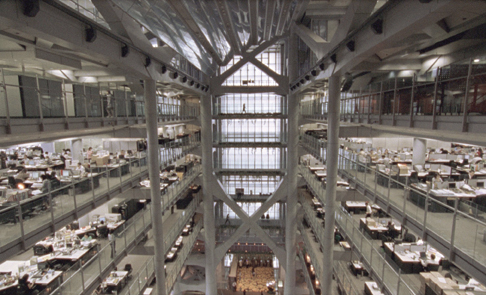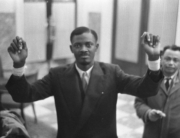
The interior of the HSBC Main Building in Hong Kong (First Run Features)
This flattering portrait of the renowned British modernist architect Norman Foster is an inspiring story of how a working-class guy from Manchester rose by sheer dint of talent to be named Lord Foster of Thames Bank. The documentary travels around the world for stunning views of his buildings and structures until collapsing at the end into a promotional video for his global firm.
His early biographical insights are told in the style of a 60 Minutes or Oprah interview. Directors Norberto López Amado and Carlos Carcas take the septuagenarian Foster back to his small childhood home in Manchester for the first time in decades, and he relishes recounting how he talked his way into a job at an architect’s office, where his drawing skills got him noticed and a recommendation to architecture school. (He reenacts the application requirement of drawing the view from his bedroom.) Fellow students note he was the star and clear choice for a scholarship to Yale. (Is that where he lost his northern accent to sound so posh now?) Foster nostalgically describes how he and a trio of classmates, including his late wife, went out on a financial limb to start their own firm. They even went under once due to over-dependence on one client.
Except for Foster’s passion for airplanes and cross-country skiing, the personal mostly takes a back seat to wonderfully beautiful images of the dazzling range of his 40-year career, from every possible angle than most viewers could ever get to see of the soaring, floating glass and metallic curves of corporate headquarters, museums, and theaters. He now presides over a gigantic global architectural firm that designs and supervises construction of mammoth structures, such as bridges (from France to Sweden) and the world’s largest airport in Beijing. (The film’s admiration for the brigades of Chinese working 24/7 to finish it for the 2008 Olympics with no comment about their working conditions does feel like admiring the Pyramids with no thought to those who made that possible).
The title is one of the few criticisms heard. It’s a quote from Buckminster Fuller, and inspired Foster to become more environmentally conscious in his work. I was a student of Fuller’s in the 1970s, and I’ve been walking by Foster’s tower of triangles atop the landmark 1928 Art Deco Hearst Building in midtown Manhattan since it was completed a few years ago, thinking it was a rip-off of Fuller’s central design element. So I was intrigued and appreciative to learn about their friendship and Fuller’s extensive influence on his work, which is well described here beyond the usual snapshot of his geodesic domes.
Written and narrated by Foster’s authorized biographer, architecture critic Deyan Sudjic, the only other criticism is a grudging acknowledgment that Germans were not enthralled with his initial design in the 1990s of the architecturally, historically, and politically potent Reichstag for the post-unification Parliament Building, a disagreement Foster airily attributes to stingy budget limitations. From the views as the camera accompanies tourists up the walkways, it looks like listening to the client, for a change, resulted in a more inviting experience than his more imposing original plan.
The most glaring omission is Prince Charles’s criticism of the modernist architecture Foster champions. Foster was a leader in protesting the Prince’s involvement in blocking commissions to fellow modernist architect Richard Rogers, who returns the favor here with effusive compliments. There is also no mention of how Foster’s 2004 building, originally the Swiss Re headquarters, has become the visual symbol of the financial center (and excesses) of the City of London, or its popular nickname of the Gherkin as an obvious phallic symbol that now shows up in any skyline panorama of so many movies. (His Millennium Bridge, linking the banks of the Thames, also seems to be a mandatory location for filmmakers these days too. Its initial shaky engineering problems, now solved, aren’t mentioned either.) These gaps make it that much harder to listen uncritically to Foster going on about sustainability and fitting into the landscape. Fortunately, the glory of his designs is an articulate defense of his brand of modern architecture.






Leave A Comment